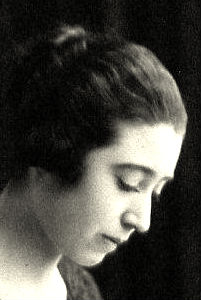Share via:
Florence Mary Anderson – Artist and stage designer, 1893-1972

Florence Mary Anderson nee MacArthur. ‘“Molly” MacArthur, the artist and stage designer, was born in Chelsea, London on 27th October 1893, the second child of the Liberal MP William MacArthur and Florence Creemer (nee Clarke). She was trained at the Westminster School of Art and was registered as a student in 1915. She married James Sinclair Standish Anderson on 15 February 1917, but appears to have used his name professionally from at least 1914.
She painted a series of postcards for Mansell, but is best known as an illustrator of children’s books. She illustrated at least thirty books between 1914 and 1935. Her first major commission appears to have been an extensive suite of colour illustrations prepared for Lady Margaret Sackville’s The Dream Pedlar, published in 1914.
There followed works such as The Rainbow Twins (Joseph Johnson, 1919), China Clay by Trevor Blakemore (W. Heffer & Sons, 1922), Eleanor Farjeon’s Come Christmas (Collins, 1927) and Tribute (Pelican Press, 1925) in which her artwork accompanied her own writing. In collaboration with her friend, Helen Simpson, she illustrated Mumbudget, an Irish fairy-tale (Heinemann, 1928). She also contributed to nursery comics like Little Folks and Tiny Tots as well as Cassell’s Children’s Annual and Cassell’s Family Magazine.
Between 1910 and 1936 she lived as part of an artistic community in the Strand, Chiswick. She had always used the name Molly MacArthur for her monotone lino-cut illustrations, quite different in tone and style to the “fairy” art created under the name Anderson, but at some point in the 1920s she reverted permanently to her maiden name and moved into theatrical design.
Her first work for the theatre was seen at the Oxford Playhouse in 1923-4 for J.B. Fagan, and two years later she designed her first London production at the Fortune Theatre, The Cradle Song (1926). In 1931, after Anmer Hall bought the St. James’s Picture Theatre in Westminster, she and fellow designer Arnold Dunbar Smith converted it into the Westminster Theatre. There she worked for Tyrone Guthrie: A Pair of Spectacles; The Anatomist; Six Characters in Search of an Author and The Kingdom of God.
Her later West End credits include: The Green Bay Tree; Hervey House (1935); Call it a Day (1935); Love from a Stranger (1937); Mary Read; The Black Eye; Bitter Harvest; Bonnet Over the Windmill (1937); Busman’s Honeymoon; Black Limelight; and Quiet Wedding. Throughout the 1930’s she designed for Tyrone Guthrie at the Old Vic: 1933-4 The Cherry Orchard and The Importance of Being EarnestT, 1936-7 Love’s Labour’s Lost and Twelfth Night and, 1937-8 Pygmalion and The King of Nowhere for Esmé Church.
In 1937 she had accepted Esmé Church‘s invitation to design an 18th century As You Like It at the Old Vic and New Theatres “giving the setting for the most memorable Rosalind of Dame Edith Evans” (Marie Ney), and in 1939 designed VICEROY SARAH for the Old Vic’s Buxton season. The Ouds also saw her work in John Gielgud’s production of Romeo and Juliet (1932), and Twelfth Night produced by Esmé Church (1937). Other producers with whom she was associated include Basil Dean and Irene Hentschel.
During the war she served as an air-raid warden as well as doing her own work and, after it, designed austerity revues for Laurier Lister. In 1949 she renewed her association with Esmé Church who, in 1944, had accepted the invitation of the Bradford Civic Group to become director of its playhouse in Chapel Street. An important part of their work was founding and nurturing the Northern Children’s Theatre, which gave practical training to young actors in the north of England as well as entertainment for children. Robert Stephens and Edward Petherbridge are just two of the actors whose careers started there. Molly McArthur was responsible for the design of virtually all productions during the twelve years of its existence.
Molly MacArthur died in Oxford on 12th January, 1972. Her obituarist says of her: “She had a remarkable eye for stage pictures which made a deep impression on the audience and long haunted the memory of those who saw them.”
References
- Alan Horne, The Dictionary of 20th Century British Book Illustrators, Antique Collector’s Club, 1994, p. 71
- Dodie Smith, Look Back With Astonishment
- Esmé Church’s obituary in The Times, 1.6.72 p.16f
- Fairies in Art
- Harcourt Williams, Old Vic Saga
- Michael Kilburn, London Theatres, New Holland Publishers, 2002, p. 140
- Miriam Gilbert, Love’s Labours Lost, Manchester University Press, 1996, p. 132
- Molly MacArthur at Theatricalia
- Florence Mary Anderson on Pinterest
- National Identity Registration Card, 1943
- O.U.D.S programme of “Twelfth Night”, June, 1937
- Richard Hugget, Binkie Beaumont
- Robertson Davies, (novelist, formerly assistant at the Old Vic Theatre School) private correspondence
- Theater Pictorial: A History of World Theater as Recorded in Drawings, Paintings, Engravings, and Photographs, University of California Press, 1953, p. 4
- The Stage, 3.2.72 p.19b
- The Times, 31.1.72 p.14g
- Westminster Theatre programme of “A Pair of Spectacles”,December 1931
- Who’s Who, 1923: M’Arthur, William Alexander
Online reference
Florence Mary Anderson on Wikipedia
Note: This Biography was graciously provided by James Anderson. Mary Florence Anderson’s grandson. Thanks you James !

